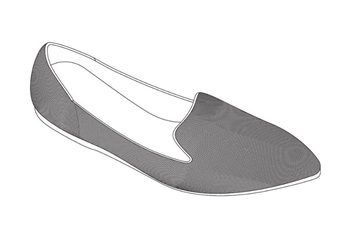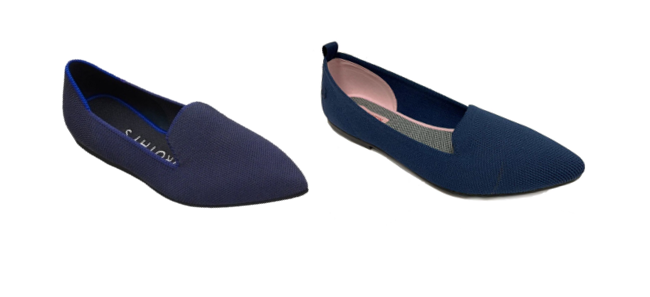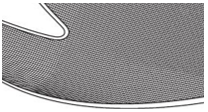A Case in ‘Point’: Rothy’s succeeds in perhaps the UK's final Community design case
Rothy’s, the popular shoe company from California, has today prevailed over Austrian company Giesswein — in what might be the UK’s final ruling on EU design rights.
As the Brexit transition period draws to a close this month, the Intellectual Property Enterprise Court has handed down judgment in favour of the Claimant, in Rothy’s v Giesswein [2020] EWHC 3391 (IPEC). The case demonstrates the importance of careful detail in design registrations.
Rothy’s asserted its registered and unregistered designs of knitted ladies’ flat shoes, against Giesswein’s similar knitted shoes:

The Registered Design

| The Unregistered Design | Giesswein’s infringing shoe |
The Judge (Deputy High Court Judge David Stone) found that Rothy’s’ Registered Community Design and Unregistered Community design right in the Rothy’s ‘Pointed Loafer’ shoe were valid, and that Giesswein’s ‘Pointy Flat’ shoe infringed the Registered design.
Background
Rothy’s is a California-based company which is well known for selling shoes, bags and accessories in its signature, knitted look, creating using recycled plastic yarn. It was common ground between the parties that Rothy’s early ballerina shoe designs (known as The Flat and The Point) were the first “ballet flats” to be made of knitted yarn made from recycled plastic. In 2017, Rothy’s expanded its knitted ballerina shoe range with the release of the Pointed Loafer, shown above.
About April 2019, Giesswein began marketing its own range of ballerina shoes in a knitted fabric made from recycled plastic, which included the ‘Pointy Flat’, also shown above.
Rothy’s claimed that the Pointy Flat infringed the following Community designs relating to the the Pointed Loafer:
(a) its registered Community design number 4500932-0002 (the RCD); and
(b) its unregistered Community design right in the design of the Pointed Loafer as first disclosed in the European Union on 24 November 2017 in images on its website, in emails and on various social media sites (the UCD).
Giesswein denied infringement and challenged the validity of those two rights for lack of individual character over two prior art shoe designs, the “Allegra K” and the “Bonnibel”, both shown below. Neither was a knitted shoe.

The RCD
Issues of Interpretation
A central issue in dispute was interpreting the registered design: what the images in the RCD show, and therefore, what is “claimed” as part of the protected design. As was famously shown by the UK Supreme Court in the Trunki case, interpretation of an RCD drawing is not always straightforward and can have important effects on the outcome of a case. This was no different.
Rothy’s argued that the RCD showed a knitted shoe.

Detail of knitted texture
The following questions were considered by the Court.
Do the black lines represent a knitted meshwork fabric, “some material texture” more generally, or “cross-hatching” to show merely that this is a three-dimensional shape?
Rothy’s submitted that the black lines show that the shoe has a meshwork/knitted upper and focused on the detail of the lines. To avoid artefacts created by printing or display on different devices, the Court was encouraged to view the original images from the EUIPO website and to zoom into the high-resolution images maintained there.
Giesswein submitted that the proper way to show a knitted texture was to use a photograph, suggesting that the use of black lines was not sufficient to convey the information Rothy’s relied on. It suggested the lines were cross-hatching showing that the design was a three-dimensional shape, similar to the CAD depiction in Trunki, or in the alternative that it showed some material texture but in a more general way than showing a knitted meshwork fabric: either a woven textile, or a “general” textured appearance including knitted, woven, meshwork or even animal hide textures.
Following the Claimant’s submissions, the judge concluded that it was clear that the RCD indicated a knitted fabric, and moreover one from a coarse yarn of the type used by Rothy’s. In reaching this conclusion, he focussed on the very fine detail of the images, and was persuaded by the fact that the lines are not consistently applied across the design, pointing as an example to the back of the shoe where the lines radiate in a circular fashion following the counterline. It was determined that the alternative textures submitted by Giesswein would not radiate in this way. Additionally, the RCD was held to be “entirely different from the CAD rendition shown in Trunki”. He therefore found that the RCD protected a shoe representing a knitted fabric.
Was the perimeter of the topline a contrasting edge created in the knitting of the shoe or a narrow uniform binding (distinct from the upper)?
In relation to this question, the Judge held that having found that the RCD indicates a knitted fabric, it would be illogical for the lines at the perimeter of the topline to represent an anti-fray border of binding of the type alleged by Giesswein. Such borders would only be required by fabrics such as woven fabrics. On the contrary, knitted fabrics are edged as part of the knitting process, and do not fray when cut. He therefore reasoned that the two parallel lines running around the perimeter of the topline indicate the contrasting edge created in the knitting process (such as the neckline of a knitted jumper).
Was the RCD asymmetrical?
Giesswein argued that there were some asymmetrical aspects in the images in the RCD which showed the different views of the shoe, for example in relation to the size and placement of the gussets, but the Judge held that having looked at expanded versions the images online, there was only a slight asymmetry that “is very difficult indeed to perceive”.
Validity
Having interpreted the RCD the court found it to be valid.
The question for the Court on validity was whether the RCD produces a different overall impression on the informed user than the Allegra K and/or the Bonnibel. The Judge took into account the six stage summary on the law on overall impression in Cantel Medical (UK) Limited v ARC Medical Design Limited [2018] EWHC 345 (Pat), the summary of the informed user in Samsung Electronics (UK) Limited v Apple Inc [2012] EWHC 1882 (Pat), the difference of the RCD from the “design corpus”, and the parties’ agreement that the relevant sector was ballerina shoes for women, the informed user is a user of ballerina shoes, the designer of ballerina shoes has a very wide degree of design freedom and there were no features of the RCD solely dictated by technical function.
The Judge noted that both experts were agreed in that, whilst fabrics knitted from heavy thread were known for shoe uppers for gym shoes and sneakers (for example the popular Nike Flyknit collection), the informed user would not be aware that they had been applied to ballerina shoes, and so the use of this material on a ballerina would strike the informed user as a significant departure from what came before.
In relation to design corpus, the Judge agreed with the conclusion of Henry Carr J’s judgment in L’Oreal SA v RN Ventures Limited [2018] EWHC 173 (Pat) that it is not necessary for it to be established that the informed user would know of an item of prior art for it to be considered as part of the design corpus.
Turning first to the Allegra K, the judge considered that its heel is significantly more pronounced than on the RCD, its material is very different to the RCD (having been made from a rubbed suede), and, unlike the RCD, it does not feature a counterline. These differences were all held to strike the informed user and the judge had “no hesitation” in concluding that the Allegra K therefore produced a different overall impression on the informed user than the RCD.
In relation to the Bonnibel, the material again was different to the RCD (having been made from suede, synthetic suede or microsuede) and unlike the RCD it did not feature a counterline. For the same reasons, the Bonnibel was also found to produce a different overall impression on the informed user.
Infringement
The Judge noted that Giesswein had, through detailed Action Storage charts, spent much time focusing on differences that it alleged existed between the RCD and the Pointy Flat, which included:
- the RCD having a straight topline with an uptick to the heel, compared with the gradual curve of the Pointy Flat;
- differences in the lengths of the vamp and tongue and angles of the gussets, which the Defendant’s expert had compared by way of millimetre measurements;
- the RCD having an asymmetry or a topline contrast which the Pointy Flat lacked (however on the Judge’s interpretation of the RCD, it was held that the RCD did not have this contrast, so this difference was not given any consideration by the Judge);
- the RCD having a gradual and sloping heel, compared with the stepped heel of the Pointy Flat;
- the Pointy Flat having a branded tab on the back of the foot to ease pulling the shoe onto the foot and a decorative button on the heel, which was absent in the RCD.
The judge did not consider that any of these differences would strike the informed user as significant, and had considered some to be difficult to perceive. It was held that the topline shape would not be striking in light of the multiple different topline designs in the design corpus.
On the shape of the sole of the shoe at the heel the informed user would pay more attention to the parts of the shoe that are visible whilst using the product, and correspondingly less attention to parts that were invisible. Further each of the heels in question were variations of well-known ways of designing a ballerina shoe and were not remarkable. For the same reason, whilst the differences in measurements and angles were discernible on a detailed side by side study of the shoes, they would not strike the informed user because they are well-known variations in ballet shoes.
The Court did not take into consideration the branded elements of the different companies, finding that it “would run rough-shod over registered design law if infringement of a registered design could be avoided simply by adding [branded elements]”. However, even if he did, they would not strike the informed user sufficiently to create a different overall impression, since an informed user may expect a level of branding on shoes over and above their design.
In concluding that the overall impression of the Pointy Flat was the same as the RCD, the Court had regard to the large degree of design freedom, and highlighted that what will strike the informed user the most in this case, as it is a feature that was a departure for ballerina shoes, is that both the RCD and Pointy Flat have uppers knitted from a heavy thread. Whilst there were some differences, which were highlighted by Giesswein, these would not be noticeable to the informed user to the extent that a different overall impression is created.
The RCD was therefore infringed by Giesswein.
UCD
The UCD was found to create the same overall impression as the Giesswein shoe; however, the court did not find on the evidence before it that Giesswein had engaged in copying the Pointy Flat.
As with the RCD, the parties disagreed on whether the Pointy Flat produced a different overall impression to the UCD, however in relation to the UCD the main area of dispute rested on one of the main differences between registered and unregistered Community designs: the additional requirement to prove that the UCD had been copied.
The Court heard evidence that Giesswein had made several visits to the Rothy’s website, discussed Rothy’s internally on several occasions, and purchased all of the shoes that were available at the time that Giesswein had visited the Rothy’s website (which did not include the Pointed Loafer, which had sold out by that time).
Although Giesswein had stated that the shoes were referred to only at the initial briefing stage, the Court noted, “the three people responsible for designing the Pointy Flat had, almost throughout that whole process…[those shoes, which] were thoroughly analysed and used throughout the process of designing the Pointy Flat”. However, the Defendant’s designers had not purchased a Pointed Loafer itself, and may not have been aware of it from their online research. The Judge declined to draw any negative inference against the Defendant for failing to adduce evidence from an additional member of the design team, stating that in IPEC, witnesses may need to be limited to ensure that a trial is held proportionately.
In relation to unconscious copying, the Judge was influenced by the fact that the Pointed Loafer was a limited edition product which was shown on the website for only a short period of time. Despite images remaining on Facebook and Instagram, the Judge did not accept that the Giesswein designers would have gone back over those postings. On the facts, the Judge also rejected the submission that Giesswein had not proved independent design (the onus having shifted to them, after counsel for Rothy’s having raised the inference of copying).
However, the Judge held that had copying been made out, the UCD would have been infringed as it produces the same overall impression on the informed user (largely for the same reasons as set out for the RCD). There were some slight differences to the UCD as compared with the RCD, but none were sufficient to make a difference to the judge’s findings in relation to the RCD and the Pointy Flat.
Validity of the UCD
For largely the same reasons as with the RCD, the UCD was found to depart from the design corpus (i.e. primarily through the use for the upper of a knitted heavy yarn) and to produce a different overall impression on the informed user than the Allegra K or the Bonnibel, so Giesswein’s validity attack on the UCD failed.
Conclusion
The Judge therefore found that the RCD and UCD were valid and that the Pointy Flat infringed the RCD.
Guidance on the role of expert evidence in design cases
Both sides used expert evidence in the case, and the scope of expert evidence was considerably wider than was originally envisaged. This led to a longer trial than usual in IPEC, and the Court criticised the use of expert evidence.
At the initial stages of the case, it had been decided by the Court that evidence should be limited to questions of design corpus, with the addition that the experts “comment upon the reasons why a design feature relied upon is or is not found in the design corpus”. The experts approached this second aspect of the evidence in very different ways, leading to an unbalanced field with the Defendant’s evidence containing material that went beyond the original order. With the Defendant’s consent, the Court directed that the Claimant file a second, reply expert report with the result that both parties had expert evidence at trial which went beyond the original order.
Remarking that shoes are everyday consumer objects, the Court considered that the additional material beyond the issue of design corpus was of little assistance. The Judge commented at [35] that:
In this case, it was common ground that there were no relevant restraints on design freedom and no elements of the designs were said to be solely dictated by technical function. Both parties conceded that interpretation of the RCD was a matter for the Court, as was the identity of the informed user, and the overall impression produced on the informed user by the various designs and shoes. Shoes are basic household items, with which all people have day-to-day experience.
The court recommended a different direction in future designs cases:
Reading the experts’ reports helped me to “don the spectacles” of the informed user. However, that could readily and more cost-effectively have been achieved by an agreed, brief primer along the lines of the section I have set out below headed Shoe Design.
This is an important word of guidance for future cases. Where possible, the parties would be well advised to attempt to agree a primer and to agree, in advance, whether there are any relevant restraints on design freedom and the extent to which any elements are dictated by technical function. In this case, it was not until after the exchange of expert reports that it became clear where the issues lay: in future cases, an exchange of views in the early stages of may assist to reduce the need for expert evidence, and to position the case appropriately.
Comment
This case provides helpful guidance on interpretation of images in RCD drawings in relation to material, which could be of considerable interest to those in the fashion industry seeking registered design protection for their use of new and/or innovative material on their products. Furthermore, additional judicial guidance on the role of expert evidence in design cases is to be welcomed.
With the end of the Brexit transition period fast approaching and with it the English court’s ability to sit as a Community Design Court, this case is very likely to be the last Community design case to be decided in the UK. If so, it draws to a close a chapter in which the English courts at all levels have played a crucial role in shaping and developing Community design law since the introduction of the Community Design Regulation almost 20 years ago. In that time, the English courts have heard a host of high profile cases, many of which were of significant public interest, in wide range of fields, including air freshener bottles (Procter & Gamble v Reckitt Benckiser), tablet computers (Apple v Samsung), children’s ride on suitcases (PMS v Magmatic), vacuum cleaners (Dyson v Vax), and now recycled ballerina flats can be added to the list. Whilst many Community design cases have been decided in the IPEC, the High Court, Court of Appeal and even the Supreme Court have all given important decisions. Undoubtedly, these cases have led to a better understanding of the value of design protection in a huge range of fields and the benefits (and occasional pitfalls) of both the registered and unregistered Community design regimes. Whilst there may be no more decisions from the English courts on Community designs, that substantial body of jurisprudence will not go to waste. It will remain equally applicable to UK registered designs and the two newly created UK unregistered design rights: the so-called Continuing Unregistered Design (CUD) and Supplementary Unregistered Design (SUD).
“We care deeply about protecting the intellectual property that Rothy’s works so hard to create, and are thrilled that the Court affirmed the validity of Rothy’s registered designs and found Giesswein to be infringing. With over 200 patents and trademarks granted or pending, we will continue to vigorously enforce Rothy’s rights and hold accountable those who infringe our designs. Rothy's has loved working with Bird & Bird on this case and we have been impressed from the beginning with not only their technical expertise but also their fire and passion for this work, and for us as a client. They have worked with us and with each other seamlessly despite the challenges presented by the global pandemic, and I am so pleased to have B&B in our corner.”
- Marie Satterfield, SVP, General Counsel and Corporate Secretary at Rothy’s





